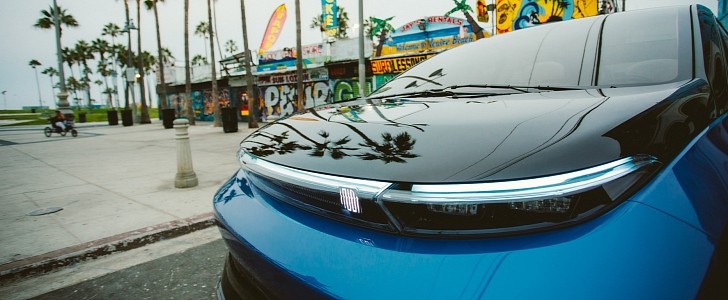Electric cars sound like the perfect opportunity for any company to become a multi-billion dollar business. The problem is that most startups fail to present a credible case. Most stick to CGI and bold claims that never materialize. Independent Electric Vehicle made its debut with a working prototype and a team behind it, but The Verge discovered that its founder is a pretty controversial character.
First, let’s present you the INDI One. We have no idea how Independent Electric Vehicle turned into INDI or IndiEV, as the company is also referred to. The electric monospace has a gorgeous design made by Andre Hudson and his design team. Hudson has worked for Hyundai and General Motors, being credited as the man who designed the 2011 Hyundai Sonata.
According to the company’s website, the INDI One is 189 inches (4.72 meters) long, 78 in (1.98 m) wide, and 67 in (1.70 m) tall. INDI did not disclose its wheelbase, but the short overhangs suggest it is more than 3 m (118 in) long. It has to be to fit a battery pack with 95 kWh, which is quite large. This component would ensure 325 mi of range to the new EV.
Tom Gage would have developed this battery pack as the head of Electric Drive Systems. He once was the CEO of AC Propulsion and currently appears on LinkedIn as the CEO of EV Grid. His company conceived the Tzero, the sports car that inspired Martin Eberhard to found Tesla with Marc Tarpenning. Gage is also the man who created the battery pack for the MINI E program.
The INDI One would weigh 5,500 pounds (2,495 kilograms), have a top speed of 130 mph (209 kph), carry 43 cubic feet (1,274 liters) of cargo, and cost $45,000. The company expects to start selling it by the end of 2022, which is only feasible if the car is in its final development stage.
With a working prototype and serious folks behind the project, INDI could have the necessary credibility to move forward. Still, The Verge discovered some stuff about the company that really does not help it. The first is that it claims to have an integrated supercomputer onboard. INDI confessed it is just “a custom Windows PC with an i7 processor and an Nvidia RTX2080 graphics card.”
The following ones have to do with its founder, Shi Hai. The Verge discovered that the Chinese mobile game entrepreneur had been sued three times by different employees. They claimed that Shi presented racist behavior towards non-Chinese employees, disrespectful treatment, wage theft, and wrongful termination. To The Verge, the company said that the lawsuits are “frivolous.”
Even if the INDI One is a good product, the company is yet to explain where it will be manufactured, who will be in charge of production, and how it will manage to sell a car with a 95-kWh for $45,000. If that will depend on investors to be invited to its IPO or SPAC merger, INDI will have to offer more than what we have already seen to be taken seriously. It has done much better so far than most other startup attempts by presenting a credible team and a working prototype, but that is not enough. Rivian and Lucid have set a new standard for credibility that new startups have so far failed to match.
According to the company’s website, the INDI One is 189 inches (4.72 meters) long, 78 in (1.98 m) wide, and 67 in (1.70 m) tall. INDI did not disclose its wheelbase, but the short overhangs suggest it is more than 3 m (118 in) long. It has to be to fit a battery pack with 95 kWh, which is quite large. This component would ensure 325 mi of range to the new EV.
Tom Gage would have developed this battery pack as the head of Electric Drive Systems. He once was the CEO of AC Propulsion and currently appears on LinkedIn as the CEO of EV Grid. His company conceived the Tzero, the sports car that inspired Martin Eberhard to found Tesla with Marc Tarpenning. Gage is also the man who created the battery pack for the MINI E program.
The INDI One would weigh 5,500 pounds (2,495 kilograms), have a top speed of 130 mph (209 kph), carry 43 cubic feet (1,274 liters) of cargo, and cost $45,000. The company expects to start selling it by the end of 2022, which is only feasible if the car is in its final development stage.
With a working prototype and serious folks behind the project, INDI could have the necessary credibility to move forward. Still, The Verge discovered some stuff about the company that really does not help it. The first is that it claims to have an integrated supercomputer onboard. INDI confessed it is just “a custom Windows PC with an i7 processor and an Nvidia RTX2080 graphics card.”
The following ones have to do with its founder, Shi Hai. The Verge discovered that the Chinese mobile game entrepreneur had been sued three times by different employees. They claimed that Shi presented racist behavior towards non-Chinese employees, disrespectful treatment, wage theft, and wrongful termination. To The Verge, the company said that the lawsuits are “frivolous.”
Even if the INDI One is a good product, the company is yet to explain where it will be manufactured, who will be in charge of production, and how it will manage to sell a car with a 95-kWh for $45,000. If that will depend on investors to be invited to its IPO or SPAC merger, INDI will have to offer more than what we have already seen to be taken seriously. It has done much better so far than most other startup attempts by presenting a credible team and a working prototype, but that is not enough. Rivian and Lucid have set a new standard for credibility that new startups have so far failed to match.
















